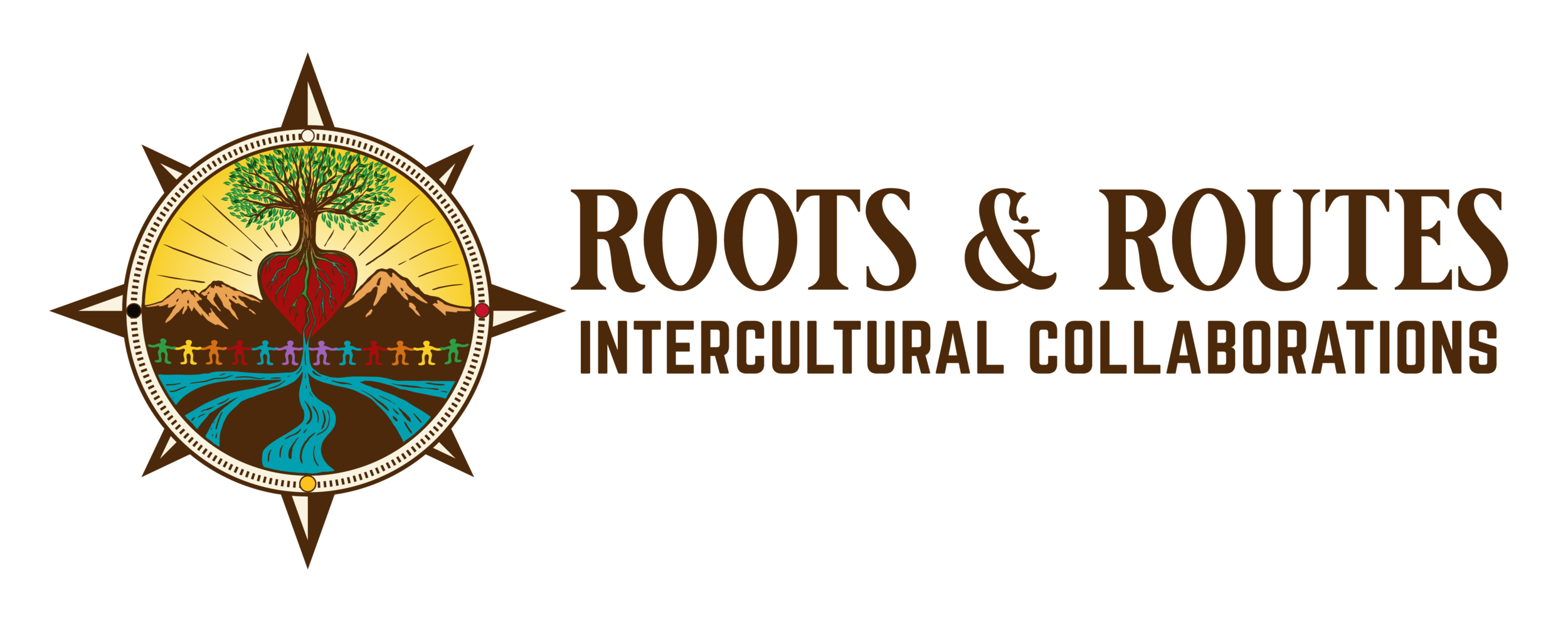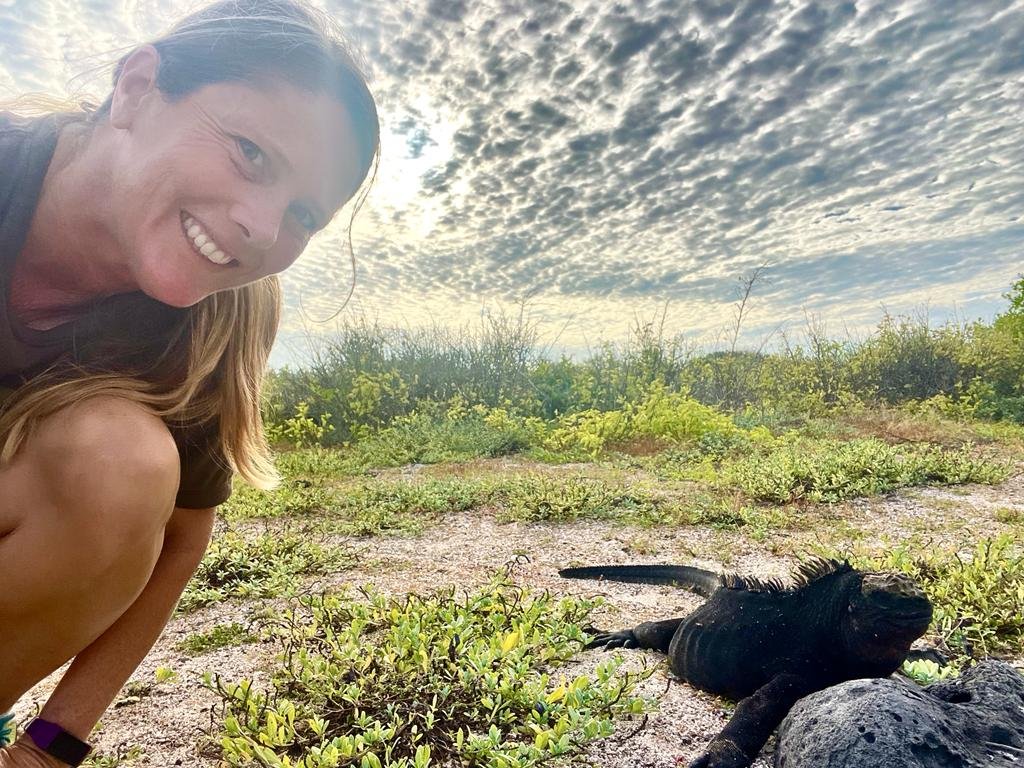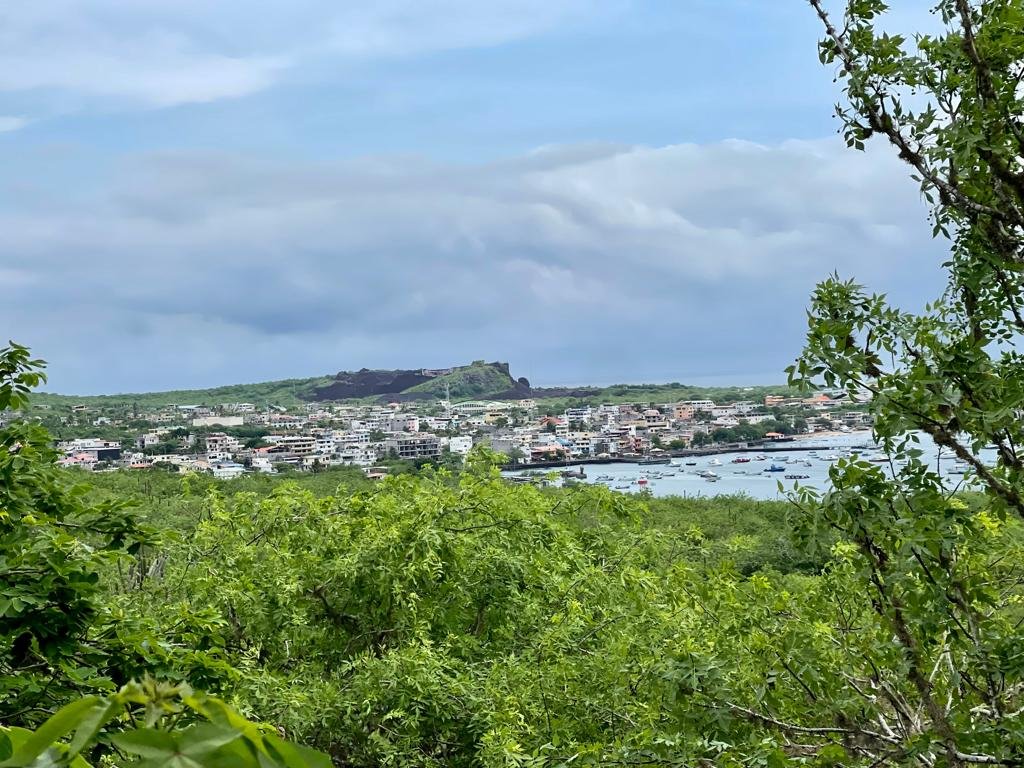Letter from R&R’s Executive Director: Bearing Gifts from the Galapagos Islands
Juli with a marine iguana, San Cristobal Island original inhabitant and teacher.
La Lobería Beach, Galapagos Archipelago, Ecuador.
Dear Roots & Routes Friends,
Spring has sprung, and it is time to celebrate rebirth! I hope that you are all feeling the same!
Up until last week, I spent the spring so far in the Galapagos Islands—a place known for adaptations and transformations. I first visited the Galapagos as a tourist in 1997. In 2012-2014, I came back a few times to teach courses in the Universidad de San Francisco de Quito local campus. I am grateful that 25-years after my first visit, I was able to return to the islands. This time around, I returned with rebirth on the horizon.
The nature of seasons is coming and going. This holds true for the time I spent in Puerto Baquerizo Moreno, San Cristobal Island. Now in Quito, Ecuador’s capital, my heart is equally filled with grieving as it is with joy and gratitude in relation to the time spent in the Galapagos. I can recognize that I am not the same person I was upon my arrival to the islands on March equinox. I carry the Galapagos with me, and as such, I bear gifts from the two months that I spent working there. I would like to share these gifts with you.
Playa La Lobería: Attuning to the Pacific Heartbeat & Learning from Marine Iguanas
Before leaving California, Hawaiian Cartographer and Roots & Routes Board President, Renee Pualani Louis—fellow geographer, friend, sister, and mentor—advised me to “… slow to the heartbeat of the land and learn from their original inhabitants.” The marine iguana in the picture above, endemic to the Galapagos, is one of the original inhabitants of this Pacific archipelago.
The marine iguanas at Playa La Loberia, on San Cristobal Island, have been my teachers and friends. Their stillness and ways of camouflaging with their lava rock surroundings have taught me about the importance of being both discrete and patient with life’s ebbs and flows. Daily, the tide unfolds in diverse waves—sometimes overpowering and fast, and sometimes, the sea is as serene as glass. While at La Loberia Beach one day, I noted:
I hear waves crash, and I hear the call of my soul to wake up and live fully in this moment.
Synching with the dynamic rhythm of the Pacific Ocean reminded me that the heartbeat of the land is ever-changing. Each wave whooshing into shore cries out of life’s continual ups and downs and of rebirth: the ever-present potential for shedding a skin and reconnecting with who and where we are.
I found that while in the Galapagos, like the marine iguanas, I too had to shed layers. No rings, necklaces, earrings, or nice clothes. I found myself feeling naked, but in a good way, like adapting to the elements by stripping down to what really matters. I spent almost the whole time in cut off jean shorts and loose t-shirts—the bare necessities.
Yes, there are Peoples in the Galapagos! Archipelago Sustainabilities
The Galapagos Islands—a purported blank slate for Darwin and, thus, a birthplace of the theory of natural selection. As western-based understandings of evolution were derived from here, the Galapagos are known mostly for their endemic animal and bird species. As such, the islands have become a cradle for scientific materialism, i.e. western science—universalism, a kind of knowledge in which diverse ways of knowing are re-interpreted in order to blend into dominant European-based and white ways of knowing. You know, where everything in life is reduced to cause and effect and where human nature and alleged “survival of the fittest” biological urges are taught as one in the same.
I wonder if for the marine iguanas, who have been here all along, such discoveries/inventions (a la Walter Mignolo) are just another wave of human constructs crashing upon their everyday Galapagos ways of being that just…are as they are. Maybe their environmental communities are at times competitive and harsh, and at others, symbiotic and peaceful.
Over the years of becoming acquainted with Galapagos human residents, I have also listened and learned from them. I have heard the stories of resident farmers, fishermen, tour boat operators, restaurant operators, teachers, government officials, and non-profit directors.
Professor Vicente Yepez with a home-grown pineapple on El Trinar Farm. Learn more or visit by going to Finca El Trinar Facebook page. Photo by Hazlewood.
This time back on San Cristobal Island, I talked with descendants of the original migrant families to the Galapagos islands, whose great grandparents were Mestizo—from mixed Indigenous and European roots. As original Galapegueños, they inherited the role of becoming stewards of this world heritage site.
El Trinar Farm house. The land has been passed down through the generations of the Guamanquishpe family, Galapagueño original inhabitants. The food and flower forest is owned and stewarded now by the Guamanquishpe/Yepez family. Photo by Hazlewood.
If you didn’t know that humans lived on the Galapagos Islands, you probably never imagined that the archipelago is a pluriverse (as opposed to a universe) of cultural peoples with associated cosmologies, or creation stories. Pluricultural, intercultural, and international communities reside together on the four inhabited islands.
I met Ecuadorian Indigenous Shuar, Montubio, Salasaca, Otovaleño, and Afro-descendants, who now also identify also as Galapageño. They carry everyday ancestral practices and knowing from their lands with them. Some of them assist original migrant families cut back the invasive plant species, and in their place, propagate productive food (and tropical flower) forests. Additionally, I met Germans, French, British, U.S., and Dutch individuals who also call the Galapagos home.
It seems to be that the majority of the archipelago residents are doing their best to take care of the lands—according to their own cultural sciences, or systems of knowing—for the good of future generations and the world. Some people are even working to make the island economies more self-sufficient, and most everyone welcomes travelers to also fall in love with the Galapagos sea- and landscapes.
A view of Puerto Baquerizo Moreno, the capital of the Galapagos and the biggest city on San Cristobal Island. Puerto Baquerizo Moreno holds 5,600 inhabitants, the second largest urban population in the Galapagos, after Puerto Ayora on Santa Cruz Island.
The take-away lesson: The Galapagos Islands cannot be understood as “nature”, free and separate from the ways that humans have adapted to the islands and vice versa. Nor is it a place of unidirectional species evolution uninterrupted by human history. For, extensive Indigenous maritime ways are just beginning to re-story the world.
From my short time in the Galapagos over the years, I have gathered that just one sustainability is an occidental invention. The Galapagos islands house many peoples from many places—many of whom are taught diverse origin stories according to their ancestral cultures. There are numerous cosmologies, and there are even more intersections of ways of knowing and taking care of the Earth. What’s mine? What’s yours?
As such, multiple evolutions, cultural interpretations, and approaches to the future inhabit sustainability. Such cosmovisions and diverse understandings of “living well” thrive alongside and are in conversation with one another. Thus, taking into consideration that a multiplicity of peoples and cosmovisions constitute sustainable ways forward, there are many sustainabilities.
That’s why at Roots & Routes IC we facilitate understanding and compassion between diverse cultural ways of knowing in the world. Sustainabilities of the Heart: catalyzing learning between the pluriverse of humans and more-than-humans around us how to be in sync with, and better care for, each other and all life on Earth.
Playa Mann: Receiving Second Shots at Communing with Sea Lions
In closing, I leave you with a story: Have you ever got caught up in an irrational fear? Well, I did…Galapagos sea lions—scary? No way… They’re so cute! That’s what I thought, until I didn’t…
Years ago, while snorkeling off San Cristobal, I had a run-in with a sea lion. This one mid-sized sea lion kept circling around me and charging at my mask—like 30 times, not exaggerating. Let’s just say I swam as fast as I could back to shore 😳😩😳…
I didn’t know whether the sea lion was playing or trying to show me who's boss. No one I met could confirm either way, so I stopped going all together. When I came back this year, I really wanted to start snorkeling again, but I was too scared. One morning, as I left my house to go running, I thought, “I wish I had a friend with whom I could swim.”
On my way home, I just happened to stop at Playa Mann—the exact same beach where I had the previous sea lion “incident.” There I was filming baby sea lions playing in the surf, when, lo and behold, this guy comes out of the blue and confidently dives in between all the sea lions. He headed out into the middle of the bay. I filmed it all—see my reel capturing this magical moment on Instagram.
Afterwards, I shared the video I had made and talked to him about whether he was nervous. He responded, “They won’t do anything to you.”
I found out that his name is Manuel Mejía Toro. From the Ecuadorian mainland, he’d been living on the Galapagos with his girlfriend for over a decade. He encouraged me to try swimming again and to re-cultivate my enchantment with the sea.
What Manuel tasked me with was overcoming my fears. Yet, he also kept me company in doing so. By the end of a handful of times snorkeling together over the two months that I was on San Cristobal Island, he and I swam surrounded by circling sea lions. I realized that 1) it’s worth it to face my fears and give things a second shot, and 2) the sea lions were curious and seemingly wanted to connect with us. Check out this video, filmed and created by my new friend, Manuel. He captures the alluring underwater worlds of us communing with sea lions, green sea turtles, schools of fish, and much more.
My experiences in the Galapagos that culminated in watching the entire full moon eclipse from my rooftop—a revolutionary experience. What I gathered from my varied transformations in the islands is my gift to you: In rebirth, we fine tune ourselves to where we are. Every place has its scary aspects, and we have a choice about how to confront these: fear or love.
Quito, where I am currently, for example, is not the city I once knew. In part due to the presence of drug cartels from Sinaloa, Mexico throughout the country, organized crime has greatly increased. Admittedly, feeling extra sensitive after my rebirth in the Galapagos, I am baby stepping with reluctance into my reality in Guapulo—a neighborhood where I have always lived when in Quito.
A few nights ago, I abruptly awoke from a dream. It suddenly dawned on me that the best survival strategy here in Quito is to incorporate the lessons learned when swimming with my snorkeling friend and the sea lions.
Once again I was tasked with overcoming my fears and finding my enchantment within the sea—this time, however, the sea of Quiteños. While the Galapagos and Ecuador “continente” are similar because the always-chaotic and powerful Ecuador also sends forth sneaker waves, there is no denying that there are differences in relation to bonafide risks these days. Even if bypassing my fear in both places is key, the mainland elicits proceeding with caution.
Everyday is a new day. As I move through today with love, all the people and places I care about in Quito and in the Sierra, Coast, and Amazon step into my reality. As I open to where I am, they call out to me. Even with hesitancy, I feel increasingly excited to see everyone and revisit my favorite locales. I recognize that by intentionally choosing to let love take the place of fear, I can come closer to being open-minded and open-hearted to our pathways unfolding and intertwining as one. By activating hope, I continue forward .
THANK YOU FOR JOINING ROOTS & ROUTES TO COLLABORATIVELY SPRING TO HOPE-IN-ACTION!
Wherever you are on the planet, I hope that you too are overcoming fears, and accordingly, synching with the rhythm of spring. May you feel inspired to let yourself fall in love with the living world around you, and by stepping into the expansiveness of what’s unknown, feel replenished and anew.
Roots & Routes welcomes you to savor our array of blogs bundled within R&R Seasonal Offerings #3. Our Spring 2022 issue invites you to celebrate the gift of rebirth with us! This season’s quarterly bulletin encourages you to nurture seedlings and new routines, while simultaneously staying open to sparks of spontaneity.
Thank you for joining Roots & Routes for springing to hope-in-action for greater respect among all beings and for a world based in environmental and social justice! Here’s to stewarding a pluriverse of diverse cultural sustainabilities in the Galapagos and throughout the world!
With Hope-in-Action,
Juli Hazlewood, Ph.D. in Geography
Co-Founder & Executive Director, Roots & Routes IC






